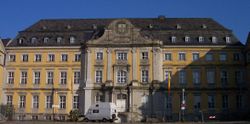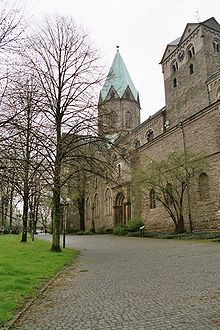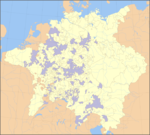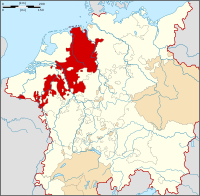- Werden Abbey
-
Coordinates: 51°23′17″N 7°00′17″E / 51.38806°N 7.00472°E
Imperial Abbey of Werden-Helmstädt
Reichsabtei Werden-HelmstädtImperial Abbey of the Holy Roman Empire ← 
877–1803  →
→Coat of arms
Main building of the former abbey Capital Werden Language(s) Low Saxon Religion Roman Catholic Government Theocracy Historical era Middle Ages - Werden founded 809 877 - Helmstadt founded 827 - Gained Reichsfreiheit May 22, 877 - Secularised to Prussia 1803 - Lost to Berg, Westphalia 1806–14 Werden Abbey (German: Kloster Werden) was a Benedictine monastery in Essen-Werden (Germany), situated on the Ruhr.
Contents
The foundation of the abbey
Near Essen Saint Ludger founded a monastery in 799 and became its first abbot. The little church which Saint Ludger built here in honor of Saint Stephen was completed in 804 and dedicated by Saint Ludger himself, who had meanwhile become Bishop of Münster. Upon the death of Ludger on 26 March 809, the abbacy of Werden passed by inheritance first to his younger brother Hildigrim I (809–827), then successively to four of his nephews: Gerfried (827–839), Thiadgrim (ruled less than a year), Altfried (839–848), Hildigrim II (849–887). Under Hildigrim I, also Bishop of Châlons-sur-Marne, the new monastery of Helmstedt in the Diocese of Halberstadt was founded from Werden. It was ruled over by a provost, and remained a dependency of Werden till its secularization in 1803.
Werden was a wealthy abbey with possessions in Westphalia, Frisia, eastern Saxony and around the abbey itself, where it had a territory of 125 km².
Under Hildigrim II the monastery, which up to that time had been the property of the family of Saint Ludger, obtained, on 22 May 877, Reichsunmittelbarkeit — the right of free abbatical election and immunity. Henceforth the abbots of Werden were imperial princes and had a seat in the imperial diets. The abbey church of Werden, destroyed by fire in 1256, was rebuilt in the late-Romanesque style (1256–75). Thereafter the monastery began to decline to such an extent that under Abbot Conrad von Gleichen (1454–74), a married layman, the whole community consisted of but three, who had divided the possessions of the abbey among themselves. After a complete reform, instituted in 1477, by Abbot Adam von Eschweiler of the Bursfelde Congregation, Werden continued until its secularization in 1803.
Early modern times
Problems arose after the Reformation when the Vögte (lords protectors) of the abbey were the Protestant rulers of Brandenburg, who had inherited the neighbouring County of the Mark.
The construction of Baroque abbey buildings, textile production and coal mining formed the economic basis of the territory of Werden in the 18th century.
The end of the abbey
During the secularization in 1803 the abbey and its territory became part of Prussia, but three years later it was incorporated into the Grand Duchy of Berg. In 1815 it became Prussian again as part of the Rhine Province. The buildings are used by the Folkwang Hochschule.
References
 This article incorporates text from a publication now in the public domain: Herbermann, Charles, ed (1913). "Werden". Catholic Encyclopedia. Robert Appleton Company.
This article incorporates text from a publication now in the public domain: Herbermann, Charles, ed (1913). "Werden". Catholic Encyclopedia. Robert Appleton Company.
 Holy Roman Empire — Imperial abbeys of the Rhenish College
Holy Roman Empire — Imperial abbeys of the Rhenish CollegeImperial abbeys and colleges
(Reichsabteien, Reichsklöster
und Reichsstifte)Buchau* • Burtscheid* • Essen* • Gandersheim • Gernrode • Herford • Hersfeld • Kaisheim† • Kornelimünster • Memleben • Michaelsberg • Niedermünster • Nienburg • Obermünster • Quedlinburg • St. Emmeram's • St. Ludger's • St. Maximin's • St. Ulrich's and St. Afra's • Thorn • Walkenried • WerdenImperial provostries and
priories (Reichspropsteien)Klingenmünster • St. BartholomäusImperial charterhouse
(Reichskartause)- Also a Prince of the Empire † Also in Swabian College
 Lower Rhenish–Westphalian Circle (1500–1806) of the Holy Roman Empire
Lower Rhenish–Westphalian Circle (1500–1806) of the Holy Roman EmpireEcclesiastical Prelates Secular Counts
and lordsfrom 1500Bentheim · Bronkhorst (until 1719) · Diepholz · East Frisia (until 1667) · Horne3 (until 1614) · Hoya · Lingen3 · Lippe · Manderscheid (until 1546) · Moers (until 1541) · Nassau (Diez · Hadamar · Dillenburg (until 1664)) · Oldenburg (until 1777) · Pyrmont · Ravensberg3 · Reichenstein · Rietberg · Salm-Reifferscheid · Sayn · Schaumburg · Tecklenburg · Virneburg · Wied · Winneburg and Beilstein · Zimerauff?from 1792Anholt · Blankenheim and Gerolstein · Gemen · Gimborn · Gronsfeld · Hallermund · Holzapfel · Kerpen-Lommersum · Myllendonk · Reckheim · Schleiden · Wickrath · Wittemstatus
uncertainCities 1 from 1792. 2 until 1792. 3 without Reichstag seat. ? status uncertain.Categories:- Imperial abbeys
- Former theocracies
- Former countries in Europe
- States of the Holy Roman Empire
- States and territories established in 877
- States and territories disestablished in 1803
- Benedictine monasteries in Germany
- Monasteries in North Rhine-Westphalia
- Essen
- Christian monasteries established in the 9th century
- Basilica churches in Germany
Wikimedia Foundation. 2010.





